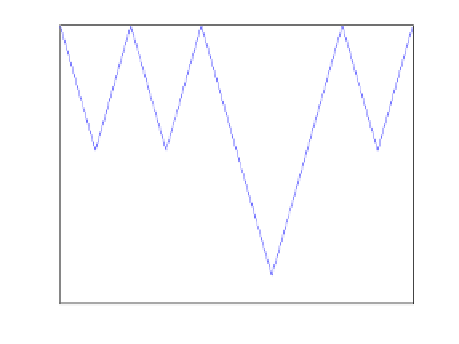Cryptography Reference
In-Depth Information
0
0.5
1
1.5
2
2.5
3
3.5
0
T
2T
3T
4T
5T
6T
7T
8T
9T
10T
Figure 2.10 - Evolution of the phase of an MSK signal as a function of time.
Using the expressions (2.36) and (2.41), the MSK signal can be written in the
form:
S
(
t
)=
A
cos
2
π
(
f
0
+
2
a
i
+
θ
i
+
ϕ
0
a
i
4
T
)
t
i
π
−
iT
≤
t<
(
i
+1)
T
(2.42)
with:
i
−
1
θ
i
=
π
2
a
i
(2.43)
n
=
−∞
The MSK signal uses two frequencies to transmit the binary symbols
a
i
=
±
1
.
1
4
T
f
1
=
f
0
+
if
a
i
=+1
(2.44)
1
4
T
f
2
=
f
0
−
if
a
i
=
−
1
We can verify that the two frequency signals
f
1
and
f
2
are orthogonal and
that they present a frequency deviation
Δ
f
=
f
1
−
f
2
=1
/
2
T
minimal. This
minimum deviation is at the origin of the name of MSK modulation.
The modulated MSK signal can also be written in the form:
S
(
t
)=
A
i
2
iT
)cos
πt
c
2
i−
1
h
(
t
−
2
T
cos(2
πf
0
t
+
ϕ
0
)
2
T
sin(2
πf
0
t
+
ϕ
0
)
(2.45)
−
i
(2
i
+1)
T
)sin
πt
c
2
i
h
(
t
−
where the symbols
c
i
are deduced from the symbols
a
i
by transition coding.
c
2
i
=
a
2
i
c
2
i−
1
and
c
2
i−
1
=
a
2
i−
1
c
2
i−
2
(2.46)
































































